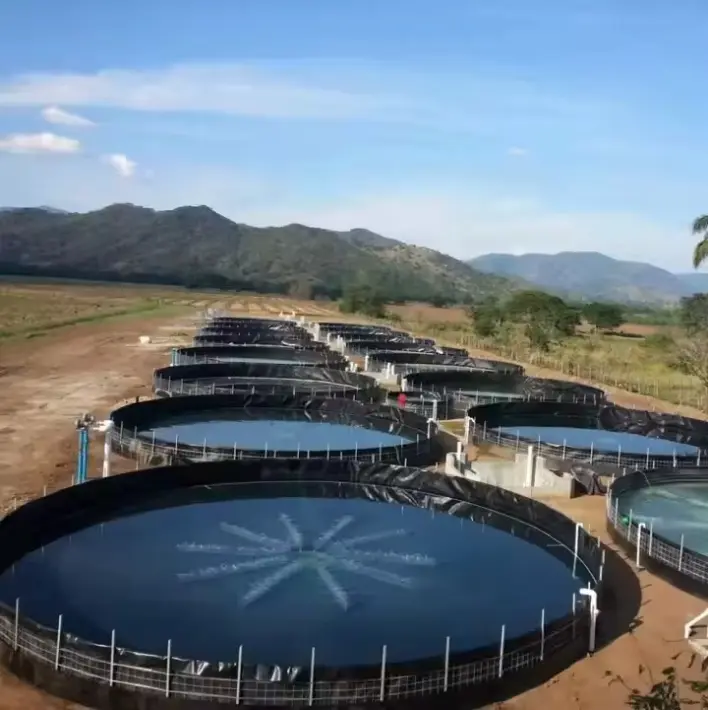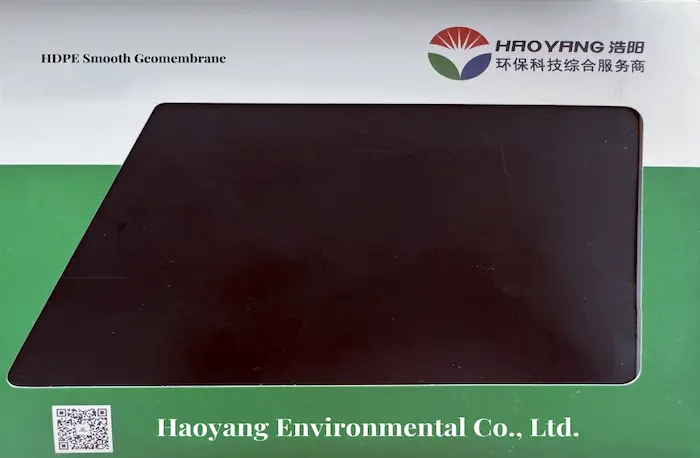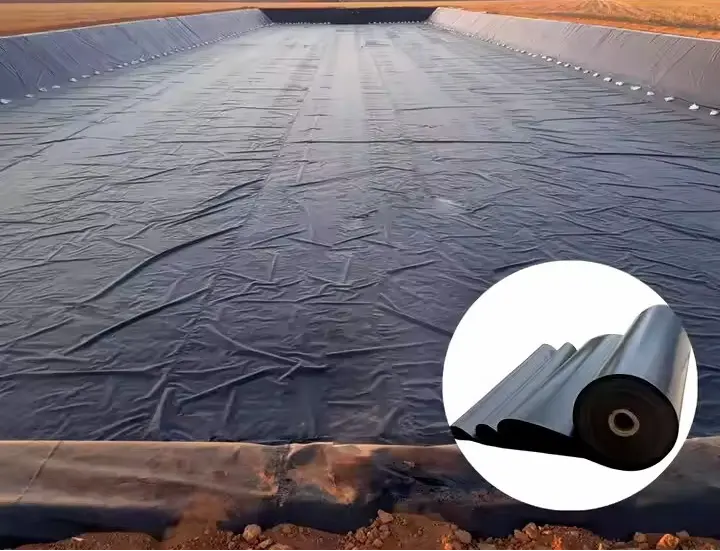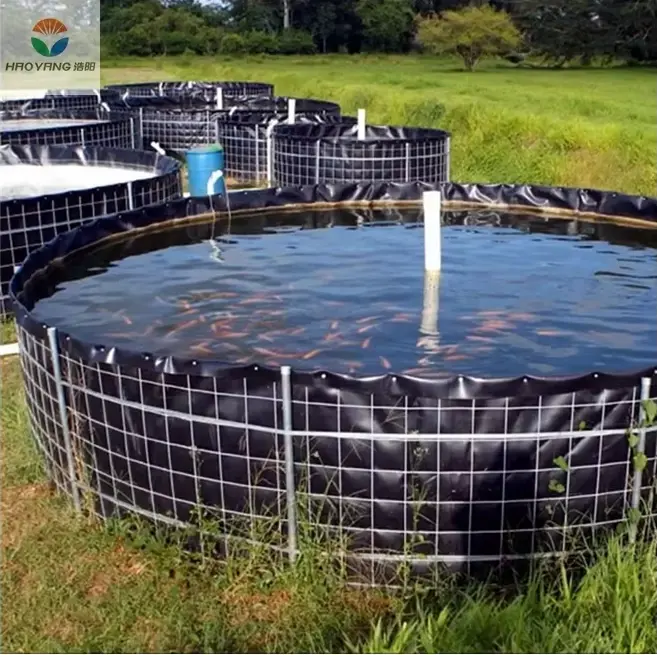Ø Definition of HDPE geomembrane
HDPE geomembrane is a waterproof and impermeable material made of high density polyethylene by special process. It has very low permeability and can effectively block liquid penetration. At the same time, it has high tensile strength, tear resistance and chemical corrosion resistance, and plays a key anti-seepage role in many projects such as aquaculture, fishing farm, landfill sites, water conservancy projects, and aquaculture ponds.

Ø The price of HDPE geomembrane
thickness | Price range (USD/m2) |
0.5mm | 0.49 - 0.60 |
1.0mm | 0.65 - 1.35 |
1.5mm | 0.15 - 4.00 |
2.0mm | 0.30 - 2.90 |
Ø The composition of HDPE geomembrane
composition | proportion | function |
High density | About 97.5% | As a basic material, its high molecular weight and highly crystalline structure is the key to the excellent performance of geomembrane |
carbon black | About 2.5 percent | Absorb ultraviolet rays and prevent the geomembrane |
Ø Material properties of HDPE geomembrane

1. Impermeability:
HDPE geomemofilm has a very low permeability coefficient, can effectively prevent liquid penetration, prevent water, chemical substances and other leakage, is the ideal impermeability material.
2. High strength:
with high tensile strength and tear strength, can withstand a certain amount of pressure and tension, not easy to break, adapt to a variety of complex engineering environment.
3. Chemical resistance:
It has corrosion resistance to most chemical substances, and can maintain stable performance in different chemical environments and extend service life.
4. Aging resistance:
It has good anti-ultraviolet and anti-aging properties, and can keep the performance of the material stable when exposed to the natural environment for a long time, reducing the performance decline caused by aging.
5. Flexibility:
in the low temperature environment can still maintain good flexibility, not easy to crack, easy to construction and adapt to different terrain conditions.
Ø HDPE geomembrane has a wide range of applications in fisheries
1. Pond seepage control
(1) Prevent water leakage: HDPE geomembrane can effectively prevent the water in the pond from penetrating into the ground, keep the pond water level stable, and reduce water waste.
(2) Save water and costs: Reduce the need for frequent water replenishment due to leakage and reduce water costs during farming.
2. Water quality protection
(1) Isolation of harmful substances: to prevent heavy metals and harmful substances in the soil from being dissolved into the water, to avoid these substances being absorbed by fish, affecting the quality and health of fish.
(2) Reduce algae breeding: reduce the deterioration of water quality caused by algae overbreeding, reduce the risk of water eutrophication, and help maintain good water quality.
3. Pond construction and reconstruction
(1) Speed up the construction progress: the HDPE geomemofilm is light in weight and easy to lay, and can quickly complete the laying of the impermeable layer, greatly shortening the construction period and reducing the impact on aquaculture production.
(2) Flexible to terrain: With good flexibility and weldability, it can adapt to a variety of complex terrain and landforms.
4. Breeding management
(1) Easy to clean and disinfect the pond: easy to clean the pond, reduce the workload and cost of cleaning the pond. At the same time, it is also conducive to thorough disinfection and killing pathogens.
(2) Prevention of disease transmission: It can reduce the contact between pathogens and fish in the soil at the bottom of the pond, reduce the risk of disease transmission, and help improve the survival rate of fish and the efficiency of farming.
(3) Flexibility: in the low temperature environment can still maintain good flexibility, not easy to crack, easy to construction and adapt to different terrain conditions.
Ø Geomembrane construction precautions

1. Material selection and storage
(1) Specification matching: Generally speaking, the thickness of geomembrane commonly used in fisheries is between 0.5-2.0mm, and the greater the thickness, the better its strength and impermeability, but the cost also increases accordingly.
(2) Quality control: Sampling and testing of each batch of geomembrane, including tensile strength, tear strength, puncture resistance and other indicators, can be used after passing the test.
(3) Proper storage: Geomembrane should be stored in a ventilated, dry, cool place to avoid direct sunlight and rain.
2. Site treatment
(1) Thorough cleaning: completely remove sharp objects in the fishing ground to prevent these objects from piercing the membrane after the geomembrane is laid, causing leakage.
(2) Accurate and smooth: Generally, the difference of concave and convex height per square meter is not more than ±5cm.
(3) Strict compaction: the compacting degree of the foundation soil reaches more than 90%, which enhances the stability of the foundation and prevents the geomembrane from breaking due to the foundation settlement.
3. Laying construction
(1) Avoid folds: During the laying process, the geomembrane should be kept as flat as possible to avoid folds. If there are wrinkles, it needs to be adjusted in time.
4. Reserved expansion capacity:
(1) According to the local temperature conditions and the scale of the fishing ground, reasonable reservation of a certain amount of expansion. Generally, in the direction of length, 1-2m of expansion can be reserved per 100m.
(2) Lap direction: The lap direction of adjacent geomemes should be determined according to the direction of water flow and wind direction, and the general requirement is that the lap direction is opposite to the direction of water flow and opposite to the dominant wind direction.
5. Welding operation
(1) Parameter setting: According to the thickness and material of geomembrane, the best welding parameters are determined through tests. During the welding process, it is necessary to pay close attention to the change of parameters to ensure the stability of welding quality.
(2) Construction process protection: After the geomembrane is laid and welded, the walking and construction operations on it should be minimized
(3) Covering protection: After the geomembrane is laid, the soil should be covered or the protective layer should be laid in time.
Ø Summarize
HDPE geomembrane is widely used in fisheries, which can effectively prevent seepage, maintain stable water quality, reduce disease, and facilitate pond fishing and improve aquaculture efficiency. In the future, its performance will continue to be optimized, more closely combined with intelligent technology, and the application field will continue to expand, providing strong support for the green, efficient and intelligent development of fisheries.

558.webp)
241.webp)
_new879.webp)